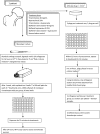Bupivacaine and triamcinolone may be toxic to human chondrocytes: a pilot study
- PMID: 21384211
- PMCID: PMC3171524
- DOI: 10.1007/s11999-011-1834-x
Bupivacaine and triamcinolone may be toxic to human chondrocytes: a pilot study
Abstract
Background: Intraarticular injections of corticosteroids combined with local anesthetics are commonly used for management of chronic pain symptoms associated with degenerative joint diseases and after arthroscopic procedures. Several studies suggest chondrotoxicity of local anesthetics whereas others report chondroprotective and cytotoxic effects of corticosteroids on cartilage. Given the frequency of use of these agents, it is important to know whether they are in fact toxic.
Questions/purposes: We asked whether (1) bupivacaine and triamcinolone acetonide, alone and combined, were chondrotoxic to chondrocytes in culture; (2) buffering of the reagents diminished toxicity of the bupivacaine and triamcinolone; and (3) the presence of the superficial layer of articular cartilage protects against toxicity.
Materials and methods: We obtained cartilage from three patients undergoing arthroplasty. To address triamcinolone acetonide, bupivacaine, and combinatorial toxicity to human chondrocytes, we set up monolayer chondrocyte cultures (n = 8 wells per condition). The question of buffering was addressed by performing the same assays as above, but the reagents were buffered. An MTT assay was used to assess chondrocyte survival in the monolayer. We harvested 21 articular plugs from each of three patients (total 63 plugs) and exposed them to the same reagents as above, including the buffered reagents. A Live/Dead assay was used to determine chondrocyte survival.
Results: Triamcinolone acetonide, bupivacaine, and their combination were toxic to human chondrocytes in the monolayer comparisons. The addition of buffering did not mitigate chondrocyte death. With the intact superficial layer in the plug group, bupivacaine was not toxic as compared with for the control group; all the other reagents (triamcinolone, combination bupivacaine/triamcinolone, buffered bupivacaine, buffered triamcinolone, and buffered combination) produced chondrotoxicity.
Conclusions: Triamcinolone induced chondrotoxicity in the articular plug and monolayer culture, whereas bupivacaine induced chondrotoxicity only in monolayer culture. The combined used of triamcinolone and bupivacaine did not show additive chondrocyte death in any arm. Buffering of bupivacaine increased its chondrotoxicity.
Clinical relevance: Although not necessarily reflecting in vivo conditions, our data suggest physicians should be cognizant of the potential in vitro chondrotoxicity of bupivacaine and triamcinolone when contemplating intraarticular administration.
Figures


Similar articles
-
The cytotoxicity of bupivacaine, ropivacaine, and mepivacaine on human chondrocytes and cartilage.Anesth Analg. 2013 Aug;117(2):514-22. doi: 10.1213/ANE.0b013e31829481ed. Epub 2013 Jun 7. Anesth Analg. 2013. PMID: 23749443
-
Thermal stress potentiates bupivacaine chondrotoxicity.Arthroscopy. 2012 Sep;28(9):1246-1254.e1. doi: 10.1016/j.arthro.2012.02.012. Epub 2012 May 11. Arthroscopy. 2012. PMID: 22579775
-
In vitro exposure to 0.5% bupivacaine is cytotoxic to bovine articular chondrocytes.Arthroscopy. 2006 Jul;22(7):693-9. doi: 10.1016/j.arthro.2006.05.006. Arthroscopy. 2006. PMID: 16843803
-
Chondrotoxic Effects of Local Anesthetics on Human Knee Articular Cartilage: A Systematic Review.PM R. 2019 Apr;11(4):379-400. doi: 10.1002/pmrj.12007. Epub 2019 Mar 15. PM R. 2019. PMID: 30676699
-
Effects of local anesthetics on articular cartilage.Am J Sports Med. 2011 Oct;39(10):2245-53. doi: 10.1177/0363546511402780. Epub 2011 Apr 22. Am J Sports Med. 2011. PMID: 21515808 Review.
Cited by
-
In Vivo Toxicity of Local Anesthetics and Corticosteroids on Chondrocyte and Synoviocyte Viability and Metabolism.Cartilage. 2015 Apr;6(2):106-12. doi: 10.1177/1947603515571001. Cartilage. 2015. PMID: 26069713 Free PMC article.
-
Effect of various factors on articular cartilage and their implications on arthroscopic procedures: A review of literature.J Clin Orthop Trauma. 2020 May;11(Suppl 3):S396-S401. doi: 10.1016/j.jcot.2019.06.017. Epub 2019 Jun 20. J Clin Orthop Trauma. 2020. PMID: 32523300 Free PMC article. Review. No abstract available.
-
Hyaluronan protects bovine articular chondrocytes against cell death induced by bupivacaine at supraphysiologic temperatures.Am J Sports Med. 2012 Jun;40(6):1375-83. doi: 10.1177/0363546512439025. Epub 2012 Mar 16. Am J Sports Med. 2012. PMID: 22427617 Free PMC article.
-
In Vitro Toxicity of Local Anesthetics and Corticosteroids on Chondrocyte and Synoviocyte Viability and Metabolism.Cartilage. 2015 Oct;6(4):233-40. doi: 10.1177/1947603515594453. Cartilage. 2015. PMID: 26425261 Free PMC article.
-
Femoroacetabular Impingement: Critical Analysis Review of Current Nonoperative Treatments.JBJS Rev. 2025 Apr 16;13(4):e24.00211. doi: 10.2106/JBJS.RVW.24.00211. eCollection 2025 Apr 1. JBJS Rev. 2025. PMID: 40238927 Free PMC article. Review.
References
-
- Bellamy N, Campbell J, Robinson V, Gee T, Bourne R, Wells G. Intraarticular corticosteroid for treatment of osteoarthritis of the knee. Cochrane Database Syst Rev. 2006;19:CD005328. - PubMed
-
- Bolt DM, Ishihara A, Weisbrode SE, Bertone AL. Effects of triamcinolone acetonide, sodium hyaluronate, amikacin sulfate, and mepivacaine hydrochloride, alone and in combination, on morphology and matrix composition of lipopolysaccharide-challenged and unchallenged equine articular cartilage explants. Am J Vet Res. 2008;69:861–867. doi: 10.2460/ajvr.69.7.861. - DOI - PubMed
Publication types
MeSH terms
Substances
LinkOut - more resources
Full Text Sources
Medical

